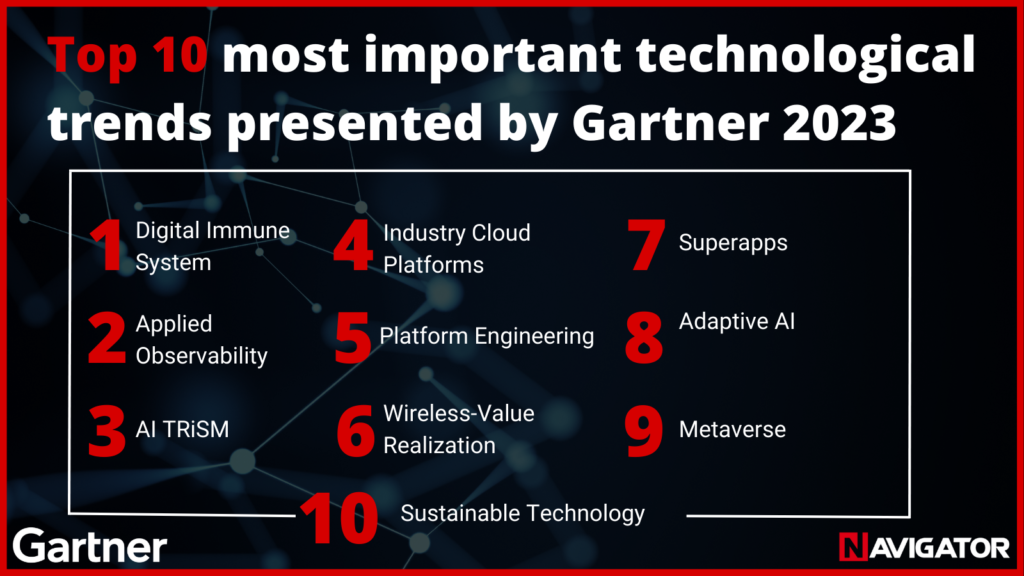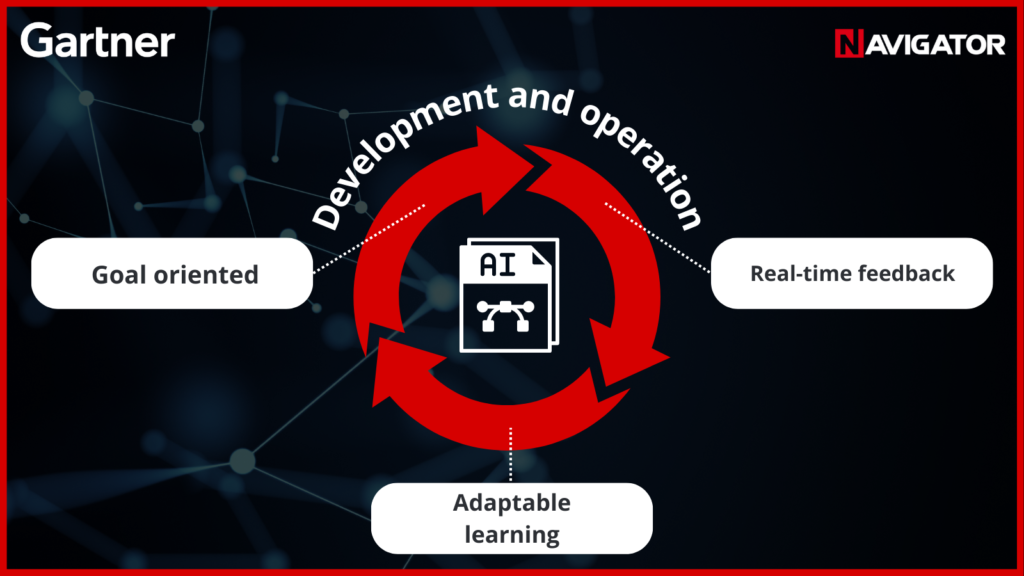Every year, the Gartner Institute publishes its predictions for business and technology for the coming year. This year is no exception – this time researchers have distinguished 10 trends that will be useful for businessmen, managers and people interested in broadly understood IT.
This list can be used to assess the possible impact of specific technology solutions on specific business strategies, such as increasing revenue, accelerating digital growth, maximizing data value, or securing and establishing a brand.
This year, the topics are divided into four sections: optimization, scaling, innovation and sustainable technology.

Theme 1: Optimization
Optimization is the improvement of processes based on the best or most efficient use of situations or resources. Every company must constantly optimize its operations to increase revenues and stay in business.
The trends outlined in this section optimize IT systems for greater reliability, improve data-driven decision making, and maintain the value and integrity of artificial intelligence (AI) systems in production.
The Digital Immune System (DIS) combines software design, development, operations and analytics practices and technologies to mitigate business risk. Robust digital resiliency protects applications and services from anomalies such as the consequences of software errors or security issues, making applications more resilient so that they recover quickly from failures.
Such a system combines multiple software engineering strategies to protect against risk. Through observability, automation, and extreme design and testing, it delivers resilient systems that mitigate operational and security risks.
Elements of the Digital Immune System:
- Continuous validation
- Autonomous tests
- Chaos engineering
- Observability
- Self-Remediation
Applied Observability is the application of observable data in a highly integrated approach across business functions, applications, as well as infrastructure and operations teams. It makes it possible to shorten the time between the actions of stakeholders and the reactions of the organization, and thus allows for proactive planning of business decisions.
It works on the data emitted by the organization, using AI to analyze and create recommendations that allow the enterprise to make faster and more accurate decisions in the future. Applied systematically, it can reduce response delays and optimize real-time business operations.

AI TRiSM, or AI trust, risk and security management, supports the management of AI models, credibility, fairness, reliability, robustness, effectiveness and data protection. It combines methods to explain AI results, quickly deploy new models, proactively manage AI security, and control privacy and ethics issues.
Did you know that…
By 2026, organizations that operationalize AI transparency, trust, and security will see their AI models achieve a 50 percent improvement in adoption, business goals, and user acceptance – Gartner
Theme 2: Scaling
Scaling is a strategic approach to business development, based on increasing revenues while maintaining a single level of costs.
These technology trends can help speed up vertical bid preparation, increase the pace of product delivery, and enable connectivity at every stage of the workflow.
Industry cloud platforms combine traditional cloud services with industry-specific functionality to address historically intractable vertical challenges.
They combine, among others, SaaS, PaaS and IaaS with industry-specific features that organizations can use in a modular model – creating composite platforms that are no longer single vertical SaaS solutions.
Platform Engineering provides a set of tools, capabilities, and processes that are packaged for easy use by developers and end users. This will increase end-user productivity and reduce the burden on development teams.
Platform engineering implements reusable tools and self-service capabilities along with automated infrastructure operations, improving developer experience and productivity.
This technological approach uses configurable, reusable application components and services.
Users benefit from standardized tools, components and automated processes.
Gartner predicts that by 2026, 80% of software engineering organizations will form platform teams as internal providers of reusable services, components and tools for application delivery. Platform engineering will ultimately solve the central problem of collaboration between software developers and operators.
Wireless-Value Realization
Gartner uses the term “wireless value realization” to describe the range of ways in which next-generation wireless technologies will soon deliver new and improved services and reduce capital costs.
This trend is accelerating digital transformation by incorporating technologies and capabilities that provide the data necessary to achieve critical business results.
Examples of innovations in wireless technologies, according to Gartner:
- Location tracking
- Radar detection
- Value-added services such as vehicle-to-vehicle communication, broadcasting, multicasting and media-specific functions to enable new use cases for wireless networking
- Omnipresence just keeps getting better. Especially in the case of the development of mobile networks and the emerging constellations of satellites in low earth orbit, which provide connectivity to the Internet and IoT in regions without connections
- Ultra-low power wireless systems
Benefits for users include risk reduction, cost optimization, compliance with connectivity regulations, and improved value propositions for developers and customers.
Theme 3: Innovation
These trends are focused on enabling business model change, reinventing how employees and customers are engaged, and accelerating strategies to conquer new virtual markets.
Superapplications are more than complex applications that aggregate services. Superapps combine app, platform, and ecosystem features into a single app, providing a platform where third parties can develop and publish their own mini-apps.
An example of such a super-application is NAVIGATOR365 – a comprehensive platform for creating applications without code. This platform gives users the tools to create their own applications – from business ones, such as CRM and Procurement Management, to those that can be used in everyday life – for example, task management.

Adaptive AI, unlike traditional AI systems, can change its own code to accommodate changes in the real world that were not known or anticipated at the time the code was written. Organizations that build adaptability and resilience into design in this way can respond to disruptions more quickly and effectively.

The Metaverse will provide economic opportunities using new types of digital business assets and value exchange models. Product development, brand placement, customer engagement and financial flows in the virtual world will need to be studied to strengthen the digital transformation strategy.
Opportunities in the Metaverse:
- Digital Presence
- Gaming
- Virtual spaces
- Shared experiences
- Spatial calculations
- Tokenized assets
Theme 4: Sustainable technology
Providing technology alone will not be enough in 2023. Sustainable technology are solutions that increase the energy and efficiency of IT services; enable enterprise sustainability through technologies such as traceability, analytics, emissions management software and AI; and help customers achieve their own sustainability goals.
Investments in sustainable technology also have the potential to create greater operational resilience and financial performance while providing new growth paths.
Get to know more about Electronic Workflow, AI, Business Intelligence and No-code applications in NAVIGATOR system
Summary
In conclusion, in 2023, enterprises need to focus on optimization, scaling and innovation, not forgetting that sustainability must also have an impact on the company’s long-term strategy.
The presented trends make it possible to adapt technological innovations to the future strategic goals of the company.
Tourism and Leisure Management graduate at IMC Fachhochschule Krems. After finishing university, she decided that digital marketing was her calling. At Archman she acts as a marketing specialist, where every day she broadens her knowledge about SEO and SEM. Mariia is keen on storytelling, and in her free time most frequently she reaches for Stephen’s King novels.





